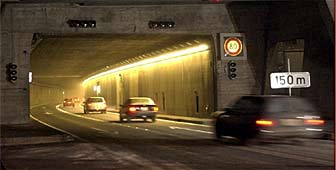Gotthard tunnel reopens despite safety concerns

The Gotthard tunnel reopened on Friday, less than two months after a fire near the southern entrance killed 11 people.
The first cars were given the all-clear to enter the tunnel late on Friday, but truck drivers had to wait until 5am on Saturday morning.
But even as the first cars were driving through Europe’s main north-south transalpine axis for the first time since October 24, safety experts were warning the decision to reopen the tunnel was premature.
On Friday afternoon, a coalition of 24 environmentalist and transport associations issued a petition calling for a ban on heavy truck traffic through the tunnel and insisting goods be shifted to the rails from the roads.
Hubert Rüegg, director of the Swiss Institute for Safety and Security, told swissinfo he did not believe any improvements to safety had been made since the incident.
“In such a short period,” Rüegg said, “it is not possible to improve the safety. It would have been better to postpone the opening and to reassess the risk in this tunnel.”
The collision of two lorries last October sparked an inferno inside the tunnel causing major structural damage.
Authorities estimate the final repair bill is likely to be in the region of SFr10-20 million ($6-12 million.
Safety standards
The Federal Roads Authority defended the decision to re-open the tunnel, saying safety standards are the “same or even higher” than before the October fire.
Michael Egger, deputy director of the authority, told swissinfo the reopening of the tunnel is subject to heightened security, including the introduction of a one-way system for lorries.
“We will also diminish the number of trucks inside the tunnel by having 150 metres of space between each vehicle, so the fire load in the case of an incident will be much lower,” Egger said.
“When we compared the safety standards inside the Gotthard with the alternatives, we concluded that reopening the tunnel was the safest way to move traffic through the Alps,” he added.
Political pressure
Rüegg believes the government was forced to reopen the tunnel for “political and financial” reasons.
“The government had to reopen the Gotthard as soon as possible to ease pressure on the [alternative] San Bernardino tunnel,” he said.
The closure of the Gotthard tunnel forced an average 19,000 passenger and freight vehicles per day to use alternative routes through the Alps.
The San Bernardino, which is not equipped to handle large numbers of heavy goods vehicles, became a flashpoint for accidents after traffic was forced to divert away from the Gotthard.
Safety debate
Rüegg says the Swiss Institute for Safety and Security has made repeated calls on the Swiss government to improve safety inside the tunnel.
“We argued clearly that the installation of a sprinkler system is an absolute necessity in tunnels of this type,” Rüegg told swissinfo.
“But this did not happen,” he added.
The institute claims the installation of a sprinkler system inside the Gotthard would reduce the risk of fire spreading by “a factor of 100”.
However, the Federal Roads Authority rejects suggestions that an automatic sprinkler system would enhance security inside the tunnel.
“It’s a bigger hazard to have sprinklers in a tunnel than not having them,” said deputy director, Michael Egger.
“You are increasing the risks…because most sprinkler systems just add water to diesel from lorries, and then the fire ignited by the diesel spreads much more rapidly than if you had no sprinklers installed.”
While debate over tunnel security is likely to continue long after the first trucks complete their journey through the Gotthard, safety experts and federal authorities agree that more needs to be done to increase public awareness about the risks of driving through tunnels.
Egger admits the likelihood of a head-on collision remains “the same” as before the fire, but says lives could be saved in future if road users are made more aware of what to do in the event of an accident.
“Unfortunately, those people who died in the Gotthard Tunnel did so not because of the incident, but because they were unaware of what the correct behaviour is inside a tunnel.”
by Ramsey Zarifeh

In compliance with the JTI standards
More: SWI swissinfo.ch certified by the Journalism Trust Initiative
You can find an overview of ongoing debates with our journalists here. Please join us!
If you want to start a conversation about a topic raised in this article or want to report factual errors, email us at english@swissinfo.ch.